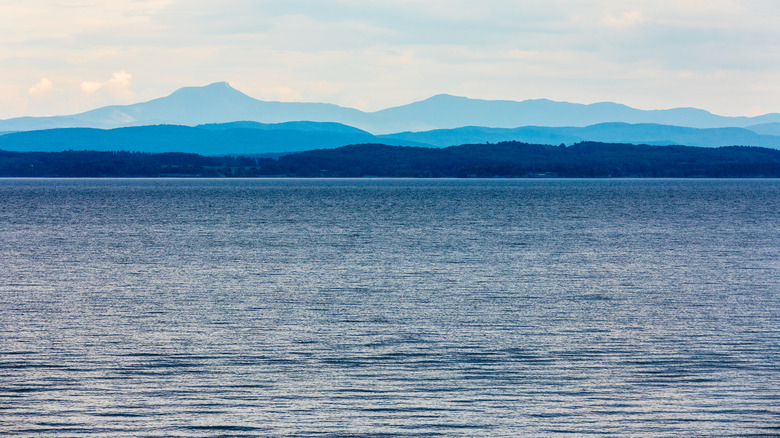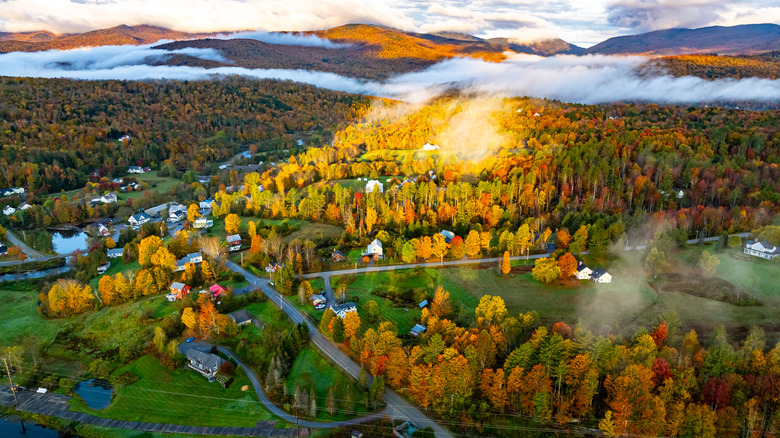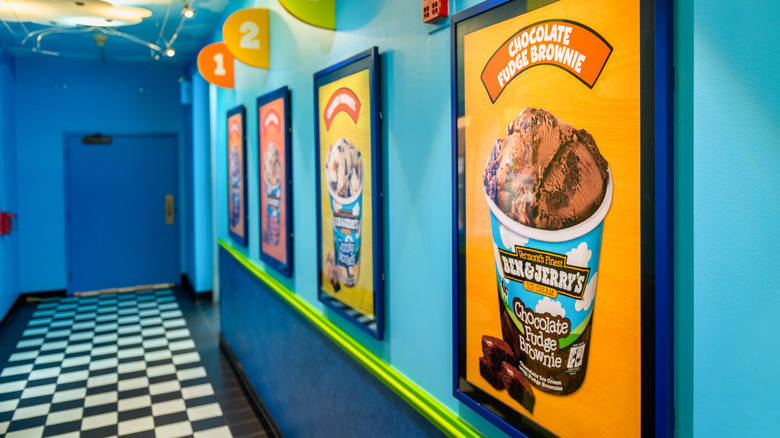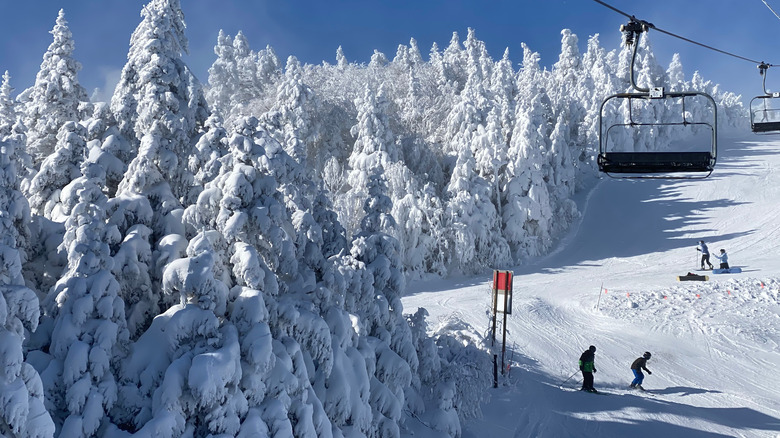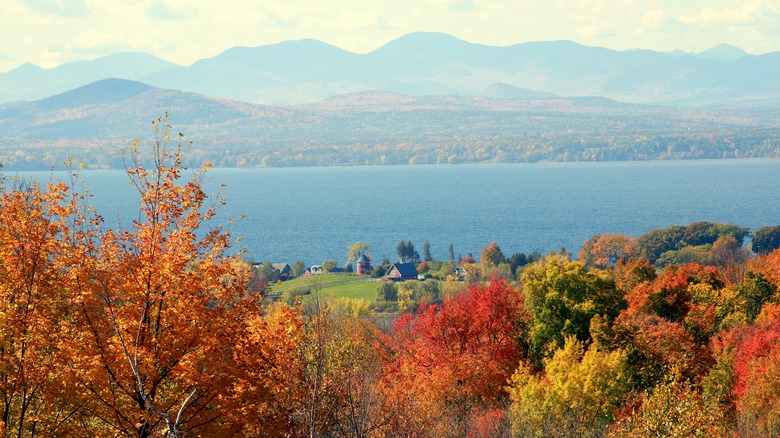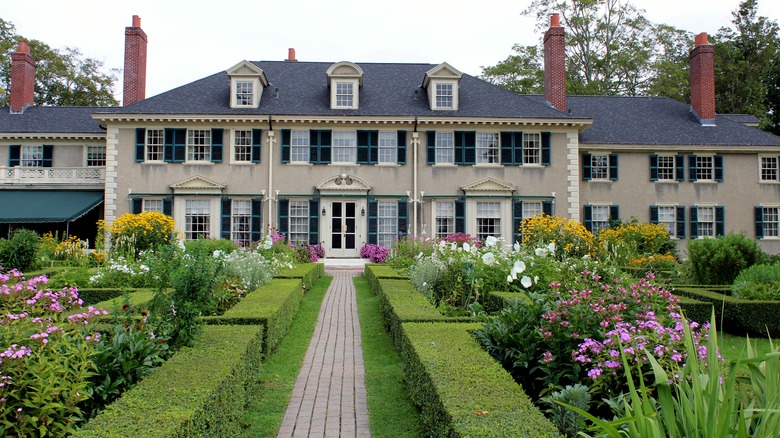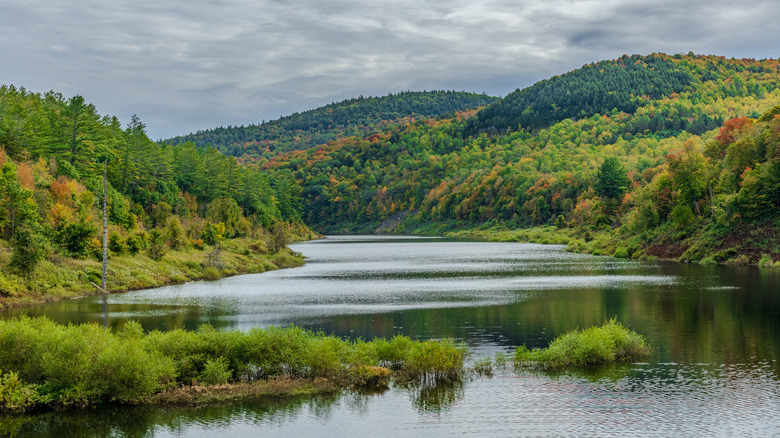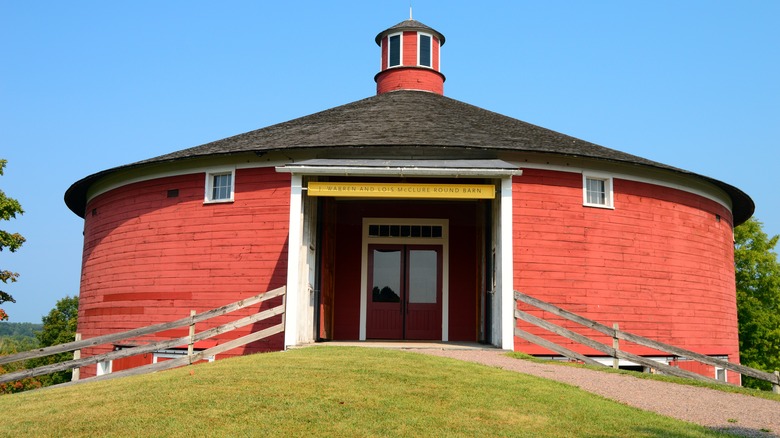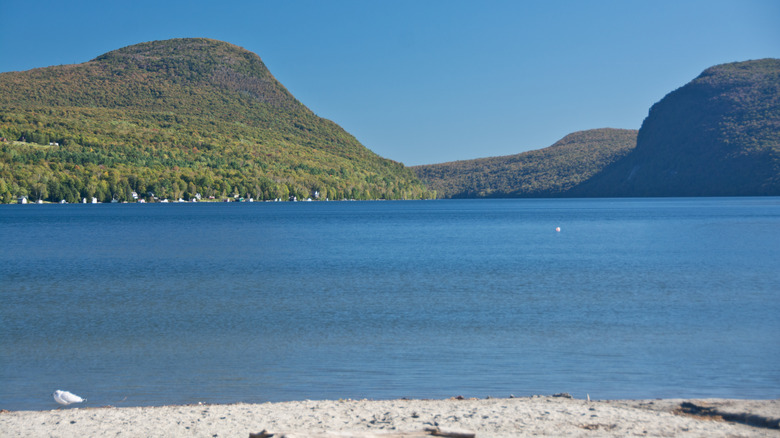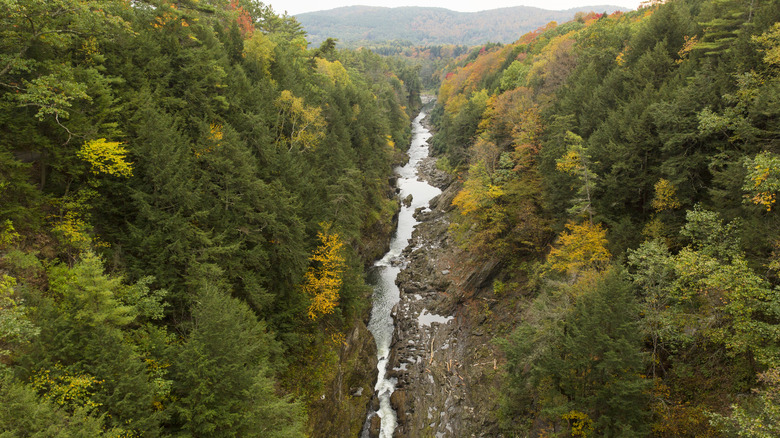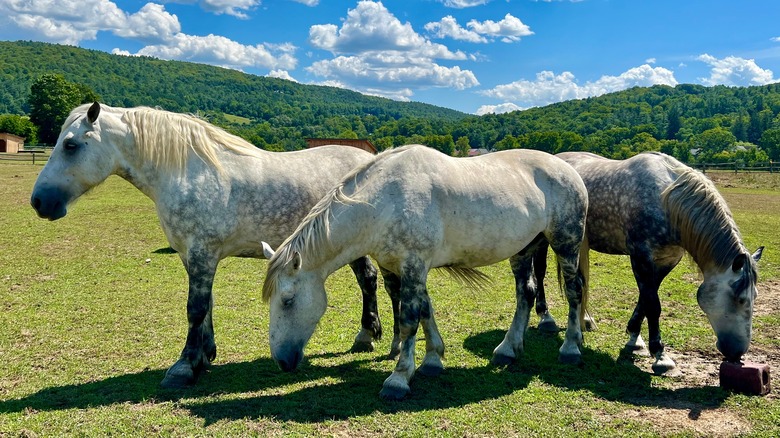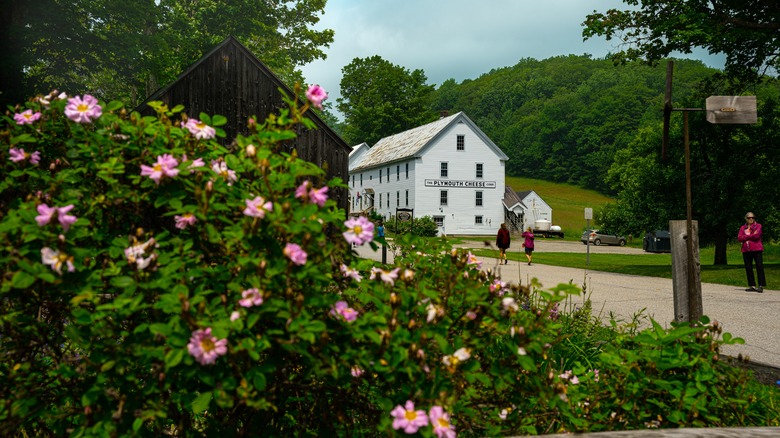Vermont's 10 Best Tourist Attractions You Should Never Skip
Vermont may not be the largest state in the United States, but it is certainly mighty. Despite its position as the sixth-smallest state in the nation, Vermont still draws millions of annual tourists to its gorgeous land of mountains, rivers, and lakes. Per the State of Vermont Agency of Commerce and Community Development, a whopping 15.8 million visitors came to the Green Mountain State in 2023 — and it's no wonder why.
After perusing hundreds of online visitor reviews and scouring local tourism boards, we have determined the 10 best spots to enjoy Vermont regardless of the weather. During the summer, visitors can try their hand at water sports like kayaking and canoeing; in the winter, cold temperatures and snowfall usher in a period of alpine and cross-country skiing. Fall in Vermont, meanwhile, is famous for its spectacular foliage and incredible photo ops. Whether you are into museums, the great outdoors, or sampling scrumptious eats, there's no denying that Vermont's unique combination of seasonal activities keeps drawing travelers back year after year.
Vermont Route 100
The iconic Route 66 may be one of the most storied routes in the U.S., but Vermont Route 100's scenic byway might as well be the most charming drive in the whole country. Over the course of 146 miles of small towns and rolling hills, visitors can get a feel for Vermont's best offerings. Start your journey at Moss Glen Falls — the tallest waterfall in the state of Vermont, which stretches 85 feet into the air and provides an awesome photo opportunity. From there, drive down to the Massachusetts border, stopping at all the sights along the way.
Foodies should definitely swing by the historic Plymouth Artisan Cheese Shop between 11 a.m. and 5 p.m. Open since 1890, this shop is home to the oldest cheddar recipe in the United States. Take a look at Plymouth's iconic cheese factory, then grab a snack for the road. If the weather is nice, you can even enjoy a picnic at the nearby President Calvin Coolidge State Historic Site. Eat at the lunch area, wander the trails, and check out the place where President Calvin Coolidge grew up. Just be aware that this location closes every year for winter.
Year-round attractions on Vermont Route 100 include boutique clothes shopping at the Vermont Country Store and events at the Weston Theater Company. As for winter fun, Gifford Woods State Park is known for snowshoeing, while Jamaica State Park provides awesome Nordic skiing. To access this route, drive 1.5 hours from Burlington International Airport.
Ben & Jerry's factory tour (Waterbury)
If Waterbury is known for its quirky vibes and delicious food, it's likely because the town is home to the Ben & Jerry's flagship factory. This iconic foodie destination was first founded back in 1985 and continues to operate to this day. In fact, the factory churns out more than 350,000 pints of its ice cream every single day. The result is an attraction that blends Vermont's rich food history with its modern culinary accomplishments — providing visitors with an experience that marries the past and the present.
To visit the Ben & Jerry's factory, travelers can sign up for a 30-minute guided tour that takes them directly into the production room. Admire the equipment, ask questions about the company's culture, and learn how the brand's iconic ice cream is made. Afterward, travelers can enjoy some complimentary Ben & Jerry's chunks and ice cream samples. Finally, wrap everything up with a stroll through the Flavor Graveyard, where visitors can learn about ice cream flavors that are no longer in production.
At the time of writing, tickets to the Ben & Jerry's factory cost $7 for adults and $1 for children 12 and under, while infants can visit for free. As for getting there, the factory is located about a 30-minute drive from Burlington International Airport. However, travelers are encouraged to stop and stretch their legs at the Bolton Potholes along the way.
Okemo Mountain Resort (Ludlow)
Every year, Vermont transforms into a winter wonderland, and there may be no better place to enjoy the snow than Okemo Mountain Resort. Located in the charming small town of Ludlow, Okemo offers some of the best slopes in the Green Mountain State. With 123 trails that snake through 667 acres of skiable terrain, the resort provides the kind of variety that will keep even the most ambitious skiers on their toes. That being said, a solid third of the runs are dedicated to beginners, while another 37% of trails are designated for intermediate skiers — leaving the remaining 30% of runs for the most advanced visitors. In practice, this well-balanced offering makes Okemo a great hill for skiers of all ability levels.
Tickets to Okemo vary considerably in price depending on how early in the season you buy them. Because of this, it's best to consult the resort's website for accurate information about day pass prices. Skiing enthusiasts, however, should know that Okemo accepts Epic Pass tickets as well as the Northeast Value Pass. The latter is ideal for anyone planning to spend the winter hopping among the East Coast's most incredible ski resorts, as it includes season-long access to 21 mountains in the region (excluding peak dates at a few key resorts). At the time of writing, Northeast Value Passes cost $684 for adults ages 18 to 64. Meanwhile, teens (13 to 17 years old) and seniors (ages 65 to 79) pay $513. Okemo is just 20 minutes away from Rutland-Southern Vermont Regional Airport.
Lake Champlain (Burlington)
Located in Burlington, the impressive Lake Champlain is a wonder to behold. Nicknamed "North America's sixth Great Lake," this 120-mile-long lake contains a whopping 6.8 trillion gallons of fresh water. This makes Lake Champlain the perfect place for visitors to kayak, paddle board, or simply take a dip. We recommend heading to North Beach Park for a traditional sandy beach where you can lounge alongside the lakeshore. Adventurers who want to explore the lake from among the waves can head to the Community Sailing Center to rent kayaks, canoes, or paddleboards for $16 per hour. The best time of year for beach vibes and water sports is summer, when average daily high temperatures in Burlington hover around 80 degrees Fahrenheit.
Lake Champlain's summer offerings may be especially enticing, but that doesn't mean that its fall and winter activities are any less attractive. During the autumn, visitors can view the spectacular contrast between the fiery fall foliage and the cool lake waters. To soak it all in, take the Island Line Trail along the lake's shore and across its waters to the Lake Champlain Islands. With 8.9 miles running through Burlington, this path is ideal for walkers, bikers, and cross country skiers. Local Motion provides bike rentals directly on the path — with three-hour-long adult rentals priced at $27 and kids' rentals going for $16. Folks who want to bike all day pay $40 for adults and $24 for kids. To visit, fly into Burlington International Airport.
Hildene, The Lincoln Family Home (Manchester)
Illinois may be the Land of Lincoln and home to Chicago's underrated Lincoln Park Garden, but Vermont has its own interesting connection to President Abraham Lincoln and his family. The popular Civil War era president had only one child to make it to adulthood, Robert Lincoln.And, in 1905, Robert built a stunning summer home in Manchester, Vermont. The estate — known as Hildene, The Lincoln Family Home — is set on 412 acres of scenic land. With delightful gardens, rustic farmland, and a beautiful turn-of-the century manor, Hildene blends natural outdoor beauty with historic charm. To experience it all, visitors can plan a day trip to this fantastic site.
General admission to Hildene costs $25 for adults and $8 for young people between the ages of 6 and 16. These tickets include access to the inside of the Lincoln family summer home and its elegant 24 rooms. In addition to the lovely Georgian revival architecture, visitors can also admire old-fashioned telephones and heating devices. Afterward, they can stroll through the Lincoln family gardens, which include 300 types of trees. Walking enthusiasts will be especially thrilled with the 12 miles of trails that wind through the estate, and animal lovers will be entranced by the alpacas, ducks, and goats that call Hildene home. The destination is a 45-minute drive from Rutland Southern Vermont Regional Airport, but visitors can stop for a picnic in Emerald Lake State Park along the way.
Green Mountain National Forest (Mendon)
To immerse yourself in a sublime natural preserve full of green trees and tranquil rivers, head to Green Mountain National Forest in Mendon. This stretch of protected land offers an unusually high concentration of rigorous hikes, with a whopping 900 miles of trails. Folks looking to soak up maximum peaceful forest vibes should check out the 4-mile-long Greendale Loop, which winds past bubbling brooks and snakes through scenic conifer trees. Meanwhile, the challenging East Dorset Trail takes hikers 4 miles each way (8 miles total) from the beauty of the national forest to one of the northernmost bits of the iconic Appalachian Trail. During the winter, the entire forest is open to cross country skiing. Winter hiking and snowshoeing are also available, but visitors should consult with local authorities to know which trails are open.
Previous visitors say that Green Mountain National Forest is free and open to the public, although this is subject to change. Be sure to ask local park rangers for updated information. Camping is also available in the national forest for folks who want to make a whole trip out of their adventure. To sleep at the remote Moosalamoo Campground, visitors must pay $15 per spot per night. Spots must be reserved at least 7 days before your trip, although they become available for online booking 6 months in advance. Green Mountain National Forest is located about an hour from Albany International Airport in Albany, New York.
Shelburne Museum (Shelburne)
For a glimpse into Vermont's unique past, swing by the Shelburne Museum. Situated in the town of Shelburne, this unique project brings together 25 historic buildings — many of which were actually transported from their original locations across the state to the 45-acre museum parcel where they are currently preserved. The result is an eclectic combination of structures from the past.
Walk through the threshold of a red round barn from 1901 before exploring the inside of a 1871 lighthouse to learn about the fascinating duties of 19th century lightkeepers. Other highlights include an inn from 1787 and a vintage Apothecary shop from 1959. As you walk from building to building, you might feel like you are hopping from one century to the next.
Adult general admission to the Shelburne Museum costs $25 online, with discounts available for seniors, veterans, and anyone using a AAA card. Meanwhile, tickets for teens cost $14, and kids 5 to 12 pay $12. To get to the museum, drive about 25 minutes from Burlington International Airport along the scenic route past Lake Champlain's Shelburne Bay. Historical visits run seasonally between May and October, although the museum offers an annual winter lights display around the holidays.
Lake Willoughby (Westmore)
There are only a few places in North America that seem straight out of a European post card — and Westmore's Lake Willoughby is one of them. Known as the "Lucerne of America," this stunning glacial lake provides the kinds of views that you would normally see in the Swiss Alps. Surrounded by dramatic mountains, Lake Willoughby offers the sort of intensive contrast that attracts photographers from afar. Bring your camera, your tripod, and your creative eye — then take the shots of a lifetime. While the lighting is probably best on a long summer day, Vermont autumns are famous for their vibrant colors and fall foliage. To capture it all, head to Lake Willoughby North Beach, a free public beach located on the northern shore. There, visitors can take pictures, soak up the views, or even take a refreshing swim.
Kayaking and canoeing are also popular activities at Lake Willoughby. Rentals are available just 10 minutes away at North Beach at Clyde River Recreation, where single-person kayaks are available for $15 per hour, and canoes and tandem kayaks cost $25 per hour. Alternatively, adventurers who are interested in spending an entire day paddling around on the lake can expect to pay $35 dollars for a single kayak or $60 for a canoe or tandem kayak. To arrive, drive 25 minutes from Northeast Kingdom International Airport in Coventry. Give yourself enough time for a pit stop at Old Stone House Museum & Historic Village to gain insight into Orleans County's fascinating history.
Quechee State Park (Hartford)
Although the Wild West may be known for its majestic natural beauty, the East Coast boasts some of the most underrated state parks in the country. Among them is Windsor County's peaceful Quechee State Park. Stretching over 688 acres of forests and rivers, Quechee State Park is the perfect place to enjoy an afternoon in the wild. The preserve's crown jewel is arguably the Quechee Gorge — a unique formation created by glacial waters 13,000 years ago. To observe this phenomenon up-close, visitors can hike the Quechee Gorge Trail, a 1.5-mile out-and-back trail that runs alongside the gorge's edge. Just keep in mind that this trail can get crowded, as it has remained popular among Vermont locals and out-of-state visitors alike.
To visit Quechee State Park, adult visitors can pay $5 per head, while children ages 4 to 13 pay $2. Toddlers 3 and under enter for free. Folks who would like to maximize their time at the park can choose to spend the night at the campground. Tent camping, cabins, and RV hook-up sites are all available from Memorial Day to mid-October. Because camping rates can vary, be sure to check the Vermont State Parks website for rates and fees. You can also guarantee your spot by making reservations online up to 11 months in advance. To visit Quechee State Park, drive about 15 minutes from Lebanon Municipal Airport in Lebanon, New Hampshire.
Billings Farm & Museum (Woodstock)
To do a deep dive into the world of Vermont dairy, head to the historic Billings Farm & Museum in the town of Woodstock. Founded back in the 1890s, Billings gives modern visitors a feel for how a dairy farm operated in the 19th century. At the museum's exhibits on farm life, travelers can learn the ins and outs of old-fashioned farming. History buffs will particularly enjoy strolling through the 1890s farm manager's house — where you can still see how the manager would have lived all those years ago.
Of course, there's more to Billings Farm than its fascinating past. Animals still live on the farm, and modern visitors can pet them. During the summer, horse-drawn wagon rides are available with the purchase of a farm and museum ticket. The winter months, meanwhile, provide the perfect conditions for a horse-drawn sleigh ride — also complimentary with any museum ticket. While visitors who stop by from May to October can enjoy a scoop of ice cream, folks who check out the farm in January and February can warm up by the fire pits.
Adult tickets to Billings Farm & Museum cost $21, while seniors ages 65 and over pay just $17, students 16 and over cost $14, and children 3 to 12 pay just $12. Littles under 3 can visit the museum for free. To arrive, drive just over 15 miles from Lebanon Municipal Airport in Lebanon, New Hampshire.
Methodology
This list of the 10 best destinations to visit in Vermont was compiled through a comprehensive analysis of traveler reviews and data compiled from local tourism boards. Each of these sites was evaluated based on factors such as visitor satisfaction, unique features, and proximity to other key attractions. Specifically, the Vermont Route 100 scenic byway was highlighted due to its proximity to many other Vermont tourism sites. Meanwhile, Okemo Mountain Resort was selected for it's well-balanced mix of ski trails catering to beginner, intermediate, and advanced levels.
When it came to choosing the top outdoors activities in Vermont, we made a point of highlighting places that were unlike anywhere else in the state. Lake Champlain and Lake Willoughby made the list, as both have been applauded for their unusually clear waters and scenic surroundings. Quechee State Park was selected for having the deepest gorge in the state. Green Mountain National Forest was also chosen for its position as the only federally funded national forest in Vermont.
In terms of Vermont's cultural and historical offering, we based our suggestions heavily on traveler satisfaction. The Ben & Jerry's factory tour is not just iconic, but it was also a huge fan favorite — earning tens of thousands of five-star reviews on Google. Similarly, Hildene and the Sherburne Museum were both massive crowd pleasers with plenty of positive reviews on TripAdvisor. Finally, Billings Farm & Museum also earned really high marks from travelers on Google.
